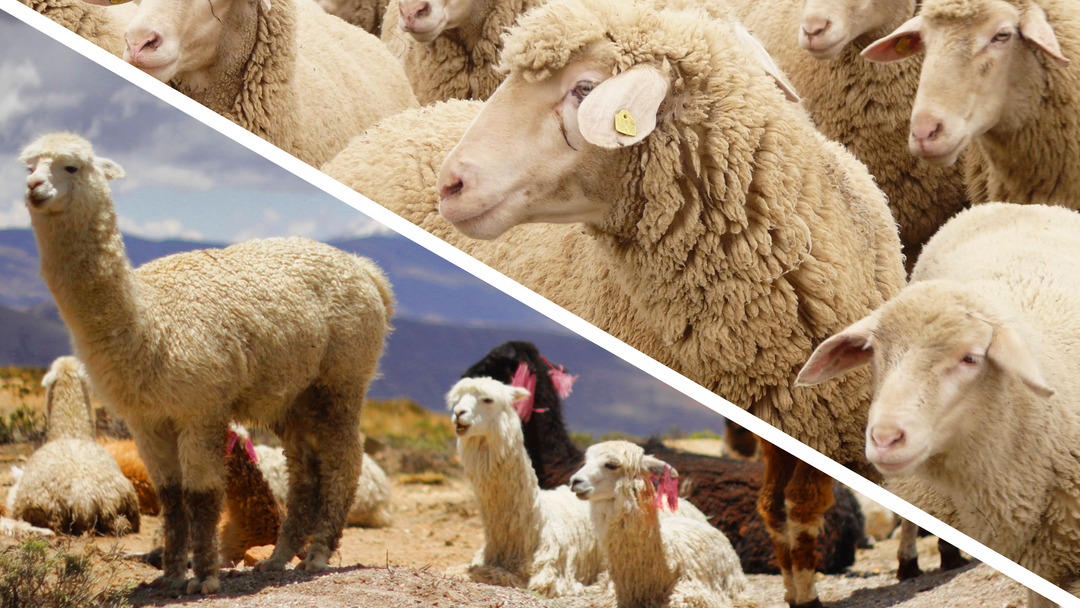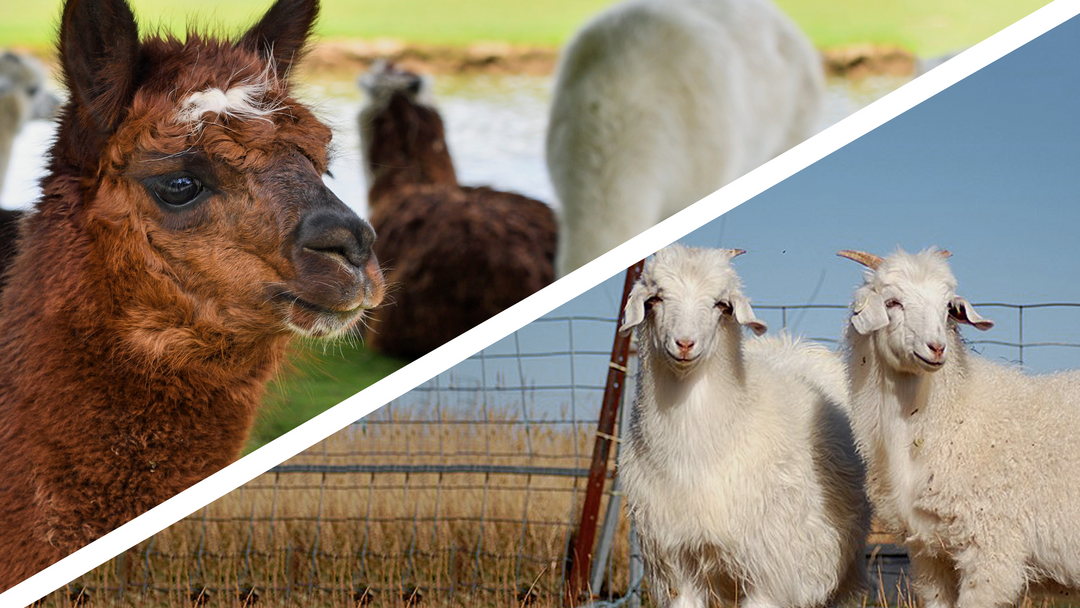Alpacas are woolly animals that belong to the camelid family. Originally from the Andes in South America, they have been kept by local people for thousands of years.
In terms of appearance, alpacas resemble llamas, but they are smaller and have shorter ears. They have a soft, dense coat that can come in a variety of colours, from white to dark brown.
Alpacas are calm and peaceful animals that are kept in herds. They have a strong instinct to stick together and protect each other. These characteristics, along with their gentle nature, make them popular animals to keep on hobby farms and as pets.
Origin and history

Alpacas are animals with a deep connection to the human history of South America, as they were crucial for human development in this region. Without alpacas, the development would have been much more difficult or even impossible, as there were no domesticated animals such as cows, horses, pigs or others in South America. Therefore, alpacas were considered man's best friend here.
The domestication of alpacas began about 6,000 or 7,000 years ago. They served as beasts of burden and warmed people with their wool. The various indigenous peoples kept large herds of alpacas. However, the conquest by the Spanish Empire brought an end to the importance of alpacas, as the Spanish brought flocks of sheep and showed no interest in the native alpaca animals. The alpaca became the farm animal of the poor indigenous population and was almost extinct. Only with the independence of the South American states was the value of the alpaca recognised again. Today, the vast majority of alpacas are found in Chile, southern Peru, western Bolivia and some specimens in northern Argentina.
Alpacas are also kept in Europe, but despite efforts to improve their quality of life on this continent, they are still adapted to the South American highlands. For this reason, we prefer to work with alpacas from South America.
Special features of the alpacas:
Alpacas are woolly animals that belong to the camelid family. Originally from the Andes in South America, they have been kept by the local inhabitants for thousands of years.
Appearance and physique:

In terms of appearance, alpacas resemble llamas, but they are smaller and have shorter ears. They have a soft, dense coat that can come in a variety of colours, from white to black and from light brown to dark brown.
Alpacas are characterised by their long, thin neck, slender and elongated legs and small heads. The biggest difference to other camels is that alpacas do not have a hump. There are two types of alpaca, the Huacaya alpaca and the Suri alpaca, which differ in their coat. The Huacaya alpaca has wavy fur and the Suri alpaca has smooth hair.
Behaviour and character:
Alpacas are social animals and live in herds. They have a strong sense of hierarchy and are very protective of their conspecifics. Alpacas are curious, intelligent and easy to train. They are usually calm animals, but also suspicious of strangers.
Another characteristic that makes alpacas special is their intelligence. Alpacas are very quick learners and respond well to human communication. Their adaptive and friendly personality makes them a great choice for people who want to use alpacas for therapy purposes or for recreational activities such as hiking or trekking.
Nutrition:
On average, alpacas and llamas consume 1.8 to 2% of their body weight in dry matter. Under pasture conditions, llamas and alpacas have the same consumption, but it is 36% lower than sheep in cultivated pastures and 26% lower in natural pastures. The variability in their diet also leads to better production of fibre in their natural state.
Overall, the diet of alpacas is environmentally friendly and sustainable for agriculture. They do not damage the grass and prefer moist grasses, which contributes to a better restoration of the environment. Also, the fact that they consume less dry matter than sheep makes them a better option for agriculture. In addition, the variability in their diet leads to better production of fibre.
Alpaca Wool

Alpaca wool is a natural and high-quality raw material that offers many advantages for the textile industry. The properties of alpaca wool, such as its fine structure, thermal insulation and moisture absorption, make it a sought-after material for garments such as jumpers, scarves and blankets. Alpaca wool is also hypoallergenic and has a natural resistance to moisture and dirt, making it particularly durable and easy to care for.
Visit our alpaca products blog to learn more about alpaca wool products.
Use
The use of alpaca wool ranges from the production of textiles for use in cold climates to the production of fashion accessories and clothing for everyday use. Alpaca wool is also used in interior design as it creates a pleasant and warm atmosphere.
Demand and market
The demand for alpaca wool has increased in recent years and the market for this raw material continues to grow. This is due to the increasing demand for natural products and the growing awareness of the benefits of alpaca wool. Many brands have realised that alpaca wool is a valuable and sustainable material and they are using it in their collections. As the demand for alpaca wool will continue to grow, the production of alpaca wool will also continue to increase, increasing its availability in the market.
Breeding of alpacas in captivity

Alpaca breeding is popular and relatively acceptable both commercially and on a hobby basis. However, it should be noted that keeping alpacas in captivity is not the best option for the animals, as they thrive best in the wild in their natural habitat.
Regular care and health monitoring
Successful alpaca breeding also involves regular care and health monitoring. Here you should make sure that the animals have enough space to run and play and also get a good diet. In addition, you should schedule regular visits to the vet in order to detect and treat diseases at an early stage.
Possibilities and regulations
It is important to remember that alpacas thrive best in their natural habitat. Although alpaca breeding is possible on a commercial as well as on a hobby basis, one should still ensure that the animals are kept in a species-appropriate manner. It is important to follow the rules and regulations of the respective country to avoid legal problems. Nevertheless, one should inform oneself about the different possibilities in order to be able to make the best decision.
It is important to mention that alpacas are happiest in their natural habitat. Although alpaca breeding can be lucrative from a financial point of view, the animal's welfare should always come first. Regular care and health monitoring is important to enjoy the cute alpacas for years to come.
Our opinion, supported by the experts.
Keeping alpacas in captivity is a controversial issue in the animal world. While breeding and keeping alpacas can be attractive to some people, it should be remembered that these animals live and thrive better in the wild.
Keeping alpacas in captivity in a species-appropriate manner requires regular care and health monitoring to ensure that the animals remain healthy and happy. However, it is important to emphasise that such husbandry is not consistent with the natural habitat and behaviour of these animals.
We recommend observing and protecting alpacas in the wild rather than keeping them as commercial products or hobby animals. Nature is the best habitat for these wonderful animals and they should be allowed to live in freedom.
We urge everyone to work to protect and preserve the alpaca population and to ensure that these animals are protected and preserved in their natural habitat.
Conclusion

Alpacas are wonderful animals with a rich history and culture. They are becoming an increasingly popular choice for clothing and home textiles as their wool is particularly soft and warm. As pet owners, alpacas offer many advantages, including their gentle and friendly personalities, low maintenance requirements and low energy needs. Alpaca fans also appreciate the animals for their beauty and personality.
While alpaca breeding may seem attractive as a commercial and hobby enterprise, it is important to note that animals in the wild have better lives and behave in a more species-appropriate manner. As animals more evolved for life in the Andes, it is best for them to live in their natural habitat and not be kept as an object of trade and ownership. It is important to respect the dignity and needs of each animal to ensure a positive future for alpacas and other animals.











